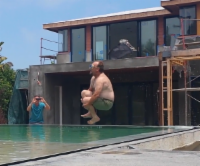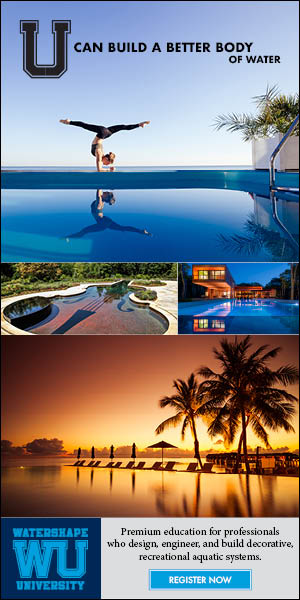Construction Systems/Materials
Renolit makes RENOLIT SOLID, a reinforced PVC membrane created to renovate and waterproof decks on both residential pools as well as in aquatic facilities. This 80-mil thick membrane upgrades decks to make them waterproof and slip-resistant for safety, the company says. A “solid” solution for common deck problems including cracks, chips, peeling paint and more. Provides long-term ease of maintenance.
Learn more here.
Kevin Cobabe takes great pride in creating equipment sets that not only look clean, but reflect an artisan touch in function and appearance. That’s why on all of his projects he finishes with a flare by painting the equipment pad plumbing, a step that protects the pipes and gives the work a professional look.
Painting pipes on pool and spa equipment pads is one of those little details that separates the pros from the pretenders. I’ve been building pools since 1986, and one of the first things my brother-in-law taught me was: paint your pipes. Protect them from UV rays, keep them clean, and give your work that finished look that says, “I cared enough to go the extra mile.”
Let’s start with the practical side of things. The Uniform Plumbing Code (UPC), Section 312.14, covers protection of piping materials and structures. It says PVC piping must be protected from direct sunlight—unless it’s covered with water-based synthetic latex paint or wrapped with enough tape. That means, like it or not, you need to put a coating of some kind on your PVC pipes.
Sure, I’ve heard the arguments that it’s somehow unnecessary: “I’ve seen PVC out there for 20 years and it’s fine!” And that’s true, sometimes it holds up. But based on my experience—and trust me, I’ve seen plenty—PVC can degrade from UV exposure. Leave a piece of pipe baking in the sun, and after a while, drop it on the ground—it’ll shatter like glass. New PVC? Drop it, and it’ll bounce. That’s the difference.
COMMON PRACTICE & COMMONSENSE
That’s why, from the very beginning of my career, I’ve painted every set of equipment—indoor, outdoor, it didn’t matter. It just became my thing. A clean equipment pad is a happy equipment pad.
Painting also helps you keep things organized. If so inclined you can even use different colors to give yourself or your clients visual cues. Darker shades for suction lines, lighter ones for returns, for example.
I even built a pool once where I really went all out: red for jet pumps, yellow for solar, blue for circulation, aqua green for the vanishing edge (pictured above). That’s not in the code—it was just me wanting to flex my creative side.
You certainly don’t have to that far to realize there is an aesthetic element to equipment pads. A neat, clean layout makes a statement. Nobody likes to see primer and blue glue smudged everywhere, like a Smurf murder scene, as some people call it. Painting those pipes shows you cared. It’s that extra step that tells the world you planned this project, you executed it well, and you put your signature on it.
And it’s not that hard—or expensive. Like any painting job, it’s 90% prep and 10% spraying. We put Ramboard down on the ground before we start, mount all the equipment on top, and slide the Ramboard out when we’re done. That keeps the floor clean. Once the plumbing is done, all you have to do is tape off the valves, toss a couple of rags over the equipment, and get to spraying. I use regular Rust-Oleum, no primer needed. One coat usually does the trick, though sometimes you’ll want to go around at the end and touch up scratches or scuffs from adjustments.
COLOR FAST
When it comes to color, I try to match the equipment brand’s theme to keep a nice monochrome look. Pentair is almond. Jandy is smoke gray. Hayward has an earthy brown tone. Sta-Rite is black. Most of the pools I’ve built—99%—have been single-color. But every now and then I’ll get a creative client and we’ll have some fun with colors.
Some repair techs grumble because they have to scrape the paint off before making repairs. But honestly, it’s easy enough to handle—use a razor blade at a ninety degree angle to the pipe as well as at a 45 to the scraping surface and it comes off quick. It’s a small price to pay for the confidence a painted pad brings your client. The cleaner everything looks, the more confidence it gives them in you as a professional.
Painting your pipes is the cherry on top. It’s like putting the star on the Christmas tree at the end of the project. That’s why I always tell my plumbing classes: painting the pipes is like signing your name. You put in the time and effort—make it yours.
So yeah, painting pool pipes isn’t just about following code. It’s about taking pride in your craft. And that’s why I always say: if you care about your work, paint your pipes.
Kevin Cobabe is president of Dynamic Pool & Spa Construction, a high-end watershaping firm based in Redondo Beach, CA. He is also a founding member of the International Watershape Institute (IWI), faculty member for Watershape University and a regular contributor to watershapes.com and the Ask the Masters Facebook group. He is also a master "gravy sommelier".
Rico Rock has added to its Jump Rock series. Made of pre-cast lightweight concrete, the rocks offer the easiest way to provide a spot for kids to jump off the pool edge into the water. These new Jump Rocks are roughly 22 inches high and made of a high-tech concrete mix. Mortared into the deck, the new designs weigh roughly 200 pounds, making them inherently stable.
Learn more here.
RENOLIT has announced the new KOLOS collection, the company’s latest line of high-performance PVC-reinforced membranes. Inspired by the power of “Colossus”- KOLOS is engineered to handle extreme exposure to chlorine, abrasive substances, and other challenging chemicals. KOLOS is backed by a 20-year waterproofing guarantee and a 5-year warranty against staining.
Learn more here.
Poolside by CGT and Trevi have collaborated to create the ‘Blizzard’ pool liner pattern that uses rich hues of deep blue color in a design that imitates the look of natural stone. The pattern gives the pool a textured look reminiscent of blue slate. The deep blue pool liner pattern that is printed on a dramatic marine blue film giving the pattern an intense, vivid color that amplifies the color intensity of the pool water.
Learn more here.
Natare manufacturers swimming pool windows that provide a clear view into the swimming or diving pool below the water’s surface, an invaluable aid for underwater photography, education, or the ultimate view of competition swimming. These strong rectangular windows are suitable for installation in any concrete or stainless-steel pool. The window installs flush with the interior pool wall, eliminating projections and sharp edges that can interfere with equipment or competition.
Learn more here.
Futurewood produces CleverDeck, a decking product made from recycled plastic, rice husks, and hardwood sawdust. The CleverDeck Xtreme version also has a pure polymer shell over the recycled core. This allows the company to create high-quality decking that is cost effective over time and easy to maintain. The composite decking materials are formulated for durability. In the harsh Australian climate where the product was developed, having composite decking that is practically waterproof, scratch and fade-resistant, and super durable is a must.
Learn more here.
For all the staying power of traditional concrete pools, alternative construction types have gained popularity in recent years for a variety of impactful reasons. Case in point, builder/designer Kevin Fleming recently turned to a pre-manufactured pool shell as a way to streamline the installation process and reduce the risk of construction defects.
...
Pentair makes its MagicFlame fire and water bowl feature with five finish options to match most poolside decors. Manufactured with durable glass fiber reinforced concrete, MagicFlame comes complete with weatherproof and anti-corrosion enclosure, electronic ignition and can be paired with a Pentair Automation system for convenient operation from anywhere at any time.
Learn more here.






















